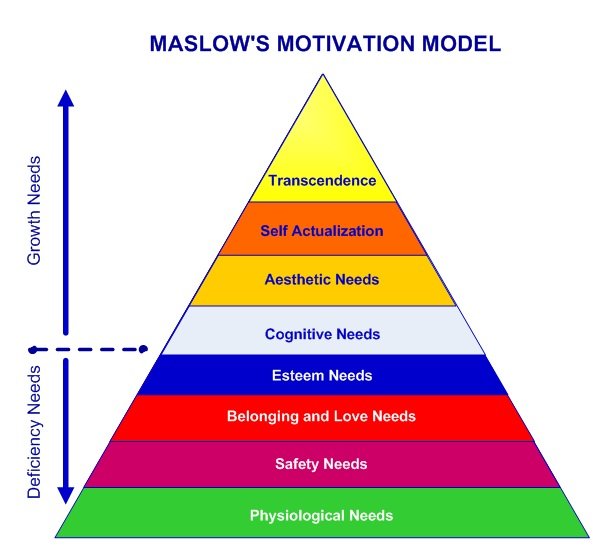Part 1: Knowing the New Targets
Why Work Today is so Unfulfilling… and How to Change It
- Part 1: Knowing the New Targets -
Are you motivated to give more, grow, and prosper, but instead find yourself dreading Monday? What about your team? Neither of you are alone.
There’s an ever-increasing number of employees and high-achieving professionals who are unfulfilled, and it’s taking a toll on both life and business.
No one wants just a job, and no one wants to live in “quiet desperation”. As leaders, we can change this. We just need to adjust our focus, see what’s new, and aim higher.
Deeper than a Headline
Finding fulfillment at both work and in life is complex. It takes personal initiative, drive, and outside support.
This article is not intended to just inspire us to begin living a more full and focused life with the hope things will also change at work. This is written for leaders who care and want to win at the office, with their employees, and beyond.
At about 1800 words, this writing could be two articles – one for work and one life. But the goal here is to connect “work-life” dots so that leaders will be inspired to design systems and processes to transcend the status quo… and in the process become more relevant, effective, and successful.
New Era
Welcome to the New. The old ways are no longer working. Conventional thinking about work and life is not only ineffective today, it has resulted in damage and loss… to both individuals and to organizations.
There is a growing epidemic of burnout, disengagement, and missed opportunity in the workplace. More and more professionals and other high achievers are forced to live with frustration and untapped potential, while others are leaving or preparing to leave successful careers… to pivot away. Maybe it’s because work is just too consuming too much of the time – leaving us with very little time or energy for other things. Maybe our careers don’t provide us the growth and excitement they once did. Or, maybe we are just at the point in life where we want more – greater meaning and purpose and more fulfillment. No matter the reason, something’s gotta give. Individuals, organizations, and even industries are struggling, trying to make sense of it. We all need an answer. And it’s not just trying to hold steady for one more year.
New Goal
The proceeding two paragraphs represent the reality faced by talent and a dilemma faced by leaders.
The goal for top talent today is to win at both work and life. And success is as much about effectively “integrating” as it is about “balance”. The question is: How best can this be done?
The first step is to understand what’s missing.
New Peak
Even if not fully understood or able to be articulated, most people want more out of life today. It’s not just about comfort, satisfaction, or happiness… it’s about joy, contentment, living our best lives to the best of our capabilities, and being meaningful contributors to something greater than ourselves.
“Most people want more out of life today. It’s not just about comfort, satisfaction, or happiness.”
–Peter C. Atherton
The problem today, however, is two-fold. First, our time, our energy, and our headspace is often consumed by work. This leaves us physically, emotionally, and mentally drained and unable to live a full life. Second, we have lost sight of our needs and what ultimately motivates us as people.
When reminded, most of us readily recall and agree with Maslow’s Hierarchy of Human Needs.
The full hierarchy is illustrated in the image below:

(Image source: McLeod, S.A. (2018, May 21). Maslow’s hierarchy of needs. Retrieved from: https://www.simplypsychology.org/maslow.html)
A summary of each need is presented below:
Physiological Needs: Basic biological needs for our survival and proper functioning, including water, food, clothing, shelter, warmth, and sleep.
Safety Needs: Security, protection, stability, freedom from fear.
Belonging and Love Needs: Social needs for connection, friendship, trust, acceptance, and intimacy.
Esteem Needs: Self-esteem and respect, status, and recognition from others.
Cognitive Needs: Need for knowledge and understanding, meaning, and predictability.
Aesthetic Needs: Appreciation for beauty, order, balance, form, and function.
Self-Actualization Needs: Realizing our full potential, becoming our best self, and seeking personal growth and peak experiences (i.e., experiencing life and the world with feelings of euphoria, joy, wonder, and praise).
Transcendence Needs: Being motivated by values and visions beyond our personal self and self-interests, living in an enlightened state, and taking action to love, support, and advance others with compassion, sympathy, empathy, and purpose.
As a reminder, the first four stages are defined as deficiency needs in that being “deficient” in one or more of them will motivate our behavior in order to satisfy them, even if our method of doing so can harm to us over time. Gratification in fulfilling these deficiency needs is often only short-term.
The second four stages, on the other hand, are attributed to our – and our employees – desire to grow and realize long-term happiness. We feel unfulfilled when one or more of these growth needs is unmet.
Although we can be motivated by different needs simultaneously, can move back and forth between different needs depending on our circumstances, and some needs can take precedence over others at any given time, we generally need to sufficiently satisfy a lower-stage need before moving onto the next level.
So, what’s missing?
For many of us, it’s transcendence and being a meaningful contributor to something greater than ourselves.
Individually, we can begin today to seek a new peak and achieve greater levels of growth and enjoyment along the way.
As leaders and organizations, we have a bigger decision to make. In deciding whether we want to be part of the answer, we must ask ourselves:
Should we have a role in helping those in our care achieve any or all levels of Maslow’s Hierarchy?
If so, how can we and how would we benefit?
An important consideration is to understand how work and workplace motivations are and can be designed to align with our human needs.
New Rules
Business – especially today – is about people.
Whether our organization is large or small, its success rests on people serving people. So, it only makes sense that our needs to thrive at work would align with our needs to do so as a human.
“Whether our organization is large or small, its success rests on people serving people.”
– Peter C. Atherton
Based on my work, research, and direct experience, I’ve developed the following hierarchy for work-related motivation as illustrated in the image below:

A summary of these needs and how they track with our human needs is presented below:
Basic Competence and Readiness Need: Our general ability to work and maintain employment. To do so, we must be sufficiently advanced in satisfying our overall human needs.
It is especially true today that we bring our “whole-self” to work. Employees at all levels need to recognize that this foundational component can be compromised at any time due to life circumstances that affect us, even if just temporarily.
Performance Need: The desire to work and produce positive results (i.e., be fruitful) is built into us. Doing so is also our largest source of “safety” on the job.
The aspects of work we are drawn to the most, however, are often connected to our work and life seasons. Early in our careers we strive to “master our craft” and “make our name”. Later, we strive to “make a difference” and “leave a legacy”.
“Early in our careers we strive to “master our craft” and “make our name”. Later, we strive to “make a difference” and “leave a legacy.”
–Peter C. Atherton
Engagement Need: To feel good about, connected to, and grow in our work, we need to be acknowledged and cared for on the job. We also need to know that our contributions matter and be recognized. This forms our sense of belonging and “love” in our work environment.
Our direct supervisor has the largest influence on engagement, especially early in our careers.
Connection Need: Early in our careers, we work mostly with our clients, teams, and supervisors. To further progress, however, we need positive and effective peer-to-peer relationships.
These relationships help us measure progress and build self-esteem. They can also be a critical source of new ideas, encouragement, support, and accountability as we expand our influence and brand both inside and outside of our organization. Unfortunately, these peer-to-peer relationships for most are comparatively weak.
Continuous Growth Need: What comes next after we have mastered our craft and made our name? Another 10, 20, or 25 years of the same? That will not inspire most professionals… and will not drive organizational growth.
As we progress into the mid-career and beyond, we need higher-levels of personal and professional development. For most technical and professional services industries, the most significant areas of need today are related to “people skills”, “mission”, and technology advancement.
Awareness and High EQ Need: The conditions and the environment where others want to be and thrive. In order to successfully lead and influence others, we need to truly know and effectively lead ourselves.
Change is constant and momentum can be a trap. To be able to advance and improve, we need to understand our past, how it has influenced our present, and how both can work together to realize a greater future. We need to know our “who”, not just our “why”, “what”, and “how”. We also need to discover our gifts and learn how best to leverage those along with our skills and talents. Our quickest and most direct path, and ability to shorten “learning curves” and eliminate “blind spots”, will be with the help of wise counsel, coaches, and mentors.
We then need to apply this to others and demonstrate a high-level of emotional intelligence (our “EQ”) and management effectiveness so that others want to be led by us.
Impact Need: The use of our skills, talents, assets, gifts, and experiences to positively change the lives and conditions of others. To make a difference and to leave a legacy.
Early in our careers this can be through our work. Later, no matter our position, prominence, or level of achievement, our new peak extends beyond our projects and our “day jobs”. Our drive will be to serve and advance others in new ways and in new contexts both inside and outside of our workplace and marketplace. And ideally this will include the communities in which we live, work, serve, and play, as well as those we are called to.
Although we progress through and between our work and workplace needs similarly to our human needs, most talent today fully recognizes and “wants” to begin to experience all these needs as they develop. This is particularly true for impact – an element with true generational convergence.
“Most talent today fully recognizes and “wants” to begin to experience all these needs as they develop.”
–Peter C. Atherton
New Results
To thrive in the new era, we need new approaches to both strategic planning and learning and development.
This article is intended to provide an initial framework to adjust our focus and aim so that we can begin to create new levels of engagement, growth, performance, achievement, and success.
Part 2 of this series focuses on what leaders and organizations can do to attract, engage, and inspire to maximize results. Part 3 focuses on how to leverage a fully engaged and motivated organization to maximize the client success.
The life, career, and organization you thought was too good to be true is not. Welcome to the new.
To your winning,

PS – Are you or your team feeling overwhelmed, or are you burning out? There is a big difference and each requires a different approach. Take this FREE quiz to find out where you stand and learn exactly how you can get back on track by clicking HERE.
PSS – Do you want to learn how to excel and prevent burnout in you and your organization? Check out relevant and important chapters of my book “Reversing Burnout” for FREE by clicking HERE.

Pete Atherton
About the Author
Peter C. Atherton, P.E. is an AEC industry insider with over 30 years of experience, having spent more than 24 as a successful professional civil engineer, principal, major owner, and member of the board of directors for high-achieving firms. Pete is now the President and Founder of ActionsProve, LLC, author of “Reversing Burnout. How to Immediately Engage Top Talent and Grow! A Blueprint for Professionals and Business Owners”, and the creator of the I.M.P.A.C.T. process.
Pete is also the host of The AEC Leadership Today Podcast and leads The AEC Leadership Mastermind.
Pete works with AEC firms to grow and advance their success through modern and new era focused strategic planning, executive coaching, leadership and management team development, performance-based employee engagement, and corporate impact design. Connect with him through the contact link below.


